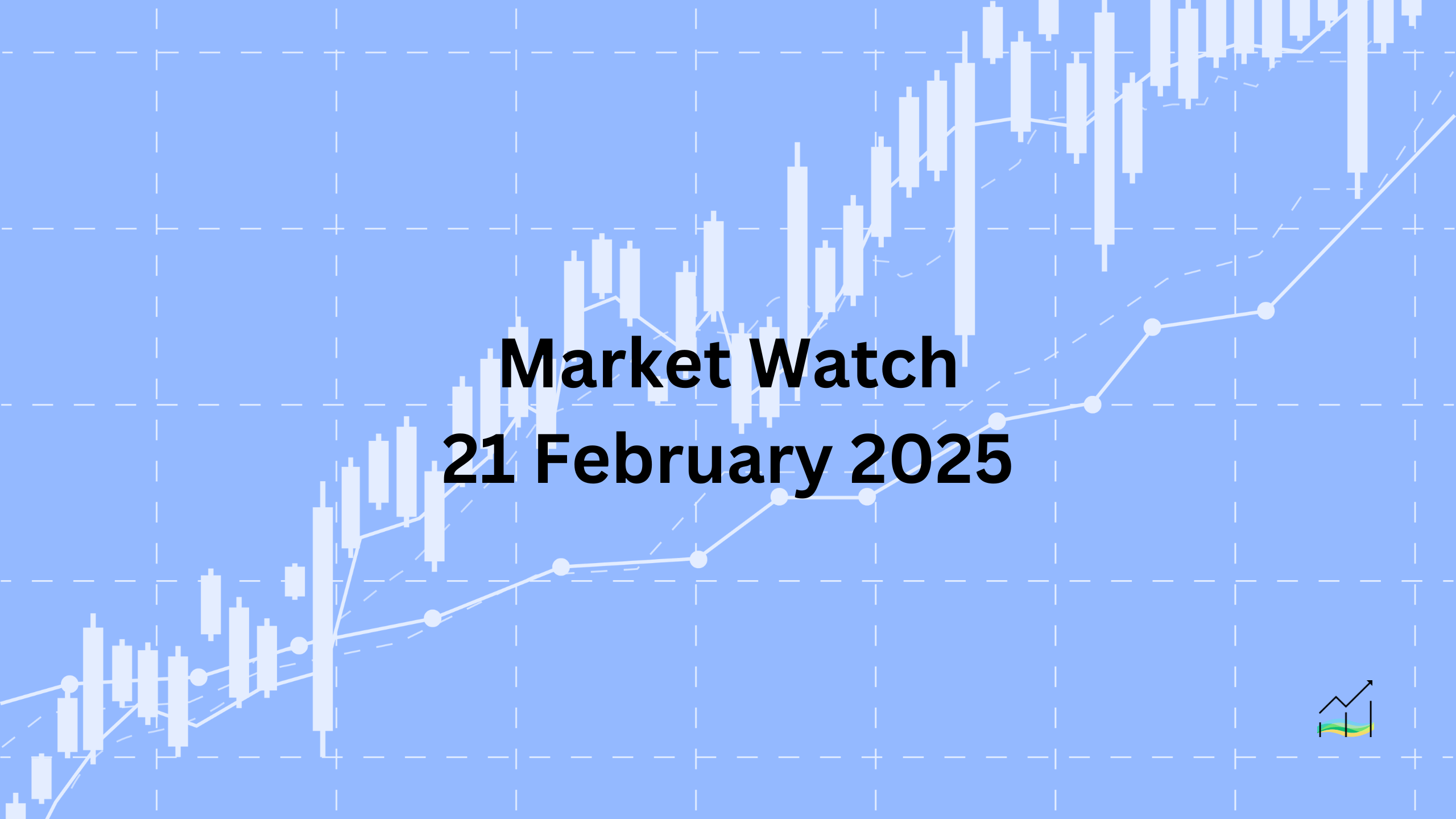21/02/2025 Market Watch

Dollar Gains as Markets Weigh U.S. Tariff Risks
The US dollar is regaining strength after recently hitting two-month lows against several G10 currencies. However, market sentiment remains cautious as investors brace for potential US tariff actions next week. US Secretary of State Rubio and Treasury Secretary Bessent did not attend the G20 meetings in South Africa, highlighting growing tensions in US foreign relations. While this is sometimes labeled as isolationism, it more accurately reflects a unilateral approach. Meanwhile, weak preliminary PMI data from the Eurozone and the UK has added to concerns, with the UK's retail sales rebound masking underlying softness. The dollar’s recovery against the Japanese yen has been supported by Bank of Japan Governor Ueda’s comments on stabilizing the bond market through potential JGB purchases. Over the past month, Japan’s 10-year yield has risen by almost 25 basis points, while US 10-year yields have declined by nine basis points. Despite today's gains, the dollar is still down approximately 1.25% for the week. The euro has struggled to hold above $1.05 and is currently near $1.0470, down 0.2% for the week.
Equities are broadly higher, with Australia being the only major Asia-Pacific market that did not participate in the rally. Mainland Chinese shares trading in Hong Kong surged over 4%, reversing the week's losses. In Europe, the Stoxx 600 is up 0.40%, rebounding from a two-day decline. If it closes higher, this would mark its ninth consecutive weekly gain, a streak that has continued since before Christmas. US index futures are mostly flat both for the day and the week. Bonds are also firmer, with European 10-year yields generally down 2-4 basis points, though UK Gilts remain unchanged. The US 10-year yield is retreating below 4.50%.
Commodities are showing mixed performance. Gold has softened, trading near $2,930 after hitting a record high of almost $2,955 yesterday. Oil prices have pulled back, with April WTI falling below $72 after reaching a weekly high of $73.15. The 200-day moving average stands near $71.45, which could serve as a key support level.
United States of America
Overview
The US Dollar Index hit a fresh two-month low near 106.35 yesterday, testing the 38.2% retracement level of its rally from late September. However, it has steadied today, returning to last week’s settlement around 106.70. A failure to close above this level would mark a third consecutive weekly decline. Earlier in the week, the index stalled near 107.40.
Economic Drivers
Investor sentiment remains cautious as inflation expectations continue to rise. The preliminary University of Michigan survey is in focus after January’s report showed a sharp jump in one-year inflation expectations to 4.3% from 3.3%, the highest level since November 2023. Longer-term (5-10 year) inflation expectations also ticked up to 3.3%, matching the highest level since 2008. Market-based inflation measures reflect similar trends, with the one-year breakeven rate rising by about 85 basis points last month and another 70 basis points this month, now just under 4.10%.
Data and Events
Today’s preliminary February PMI report is unlikely to significantly impact the market. The composite PMI is expected to rise to 53.2 after falling sharply in January to 52.7, its lowest level since last April. The University of Michigan consumer sentiment report could attract more attention, given last month’s strong inflation expectations.
Price Action
The US dollar’s recent decline reflects shifting market sentiment. The 10-year breakeven rate, which measures market inflation expectations, rose eight basis points last month and has climbed slightly higher this month to 2.46%. Despite today’s stabilization, the dollar remains vulnerable if it fails to hold key levels.
Key Points:
- Dollar Index tested two-month lows at 106.35 but rebounded to 106.70.
- Inflation expectations remain elevated, with the one-year breakeven rate approaching 4.10%.
- February PMI expected to recover slightly but may not impact markets.
- University of Michigan survey could influence sentiment if inflation concerns persist.
- Failure to close above 106.70 would mark a third straight weekly decline.
Australia & New Zealand
Overview
The Australian and New Zealand dollars have been among the strongest G10 currencies this week, second only to the Japanese yen. This comes despite both countries' central banks continuing their easing cycles, with Australia cutting rates by 25 basis points and New Zealand delivering a third consecutive 50-basis-point cut.
Economic Drivers
The resilience of the Aussie and Kiwi suggests that traders are looking beyond immediate rate cuts and focusing on broader market sentiment. While lower interest rates typically weigh on a currency, the relative strength of these two may be linked to improved risk appetite and external market factors supporting demand.
Data and Events
Australia’s February flash composite PMI showed a slight improvement, rising from 51.1 in January to 51.2. This follows a period of stagnation at 50.2 throughout Q4 2024. Despite the modest increase, the index remains below February 2023 levels, which stood at 52.1. The market reaction to the data has been muted.
Price Action
The Australian dollar settled near $0.6350 last week and showed bullish momentum yesterday, breaking above Wednesday’s high and briefly touching $0.6400—the highest level since mid-December. It reached a marginal new high today before retreating to around $0.6380. Resistance remains near $0.6424, where A$445 million in options expire today. The 38.2% retracement of the September-December decline is near $0.6415, creating a key technical zone.
Key Points:
- Aussie and Kiwi among the best-performing G10 currencies despite ongoing rate cuts.
- Australia’s PMI edged higher but remains below last year’s levels.
- Aussie price action saw a bullish breakout but faces resistance near $0.6424.
- Key technical level at $0.6415, the 38.2% retracement of the previous downtrend.
- Market sentiment appears to be supporting the Aussie and Kiwi despite policy easing.
Canada
Overview
The US dollar weakened against the Canadian dollar for the first time this week, briefly dipping below Wednesday’s low of CAD1.4175. Last week, the pair hit a two-month low near CAD1.4150. Despite this, the USD is testing CAD1.4200 in European trading today.
Economic Drivers
Fresh trade concerns are emerging as former President Trump recently hinted at potential tariffs on additional industries, including lumber. Canada, which supplies 45% of US lumber imports, is particularly exposed. Previously postponed 25% tariffs (with 10% on energy) are set to resurface on March 4, followed by metal tariffs on March 12, raising further risks for Canada. Auto tariffs also remain a looming threat. Despite the USMCA agreement from Trump’s first term, it is unclear whether Canada will be exempt from these measures.
Data and Events
Statistics Canada is set to release December retail sales data, which is expected to show a strong 1.6% increase. This rise was likely driven by a mid-month tax holiday, which has since expired as of February 15. The temporary nature of the boost suggests retail demand could soften in the coming months.
Price Action
The Canadian dollar strengthened as the greenback fell below CAD1.4175, testing a key support level. A further break below CAD1.4150 would mark fresh multi-month lows. However, USD/CAD is rebounding toward CAD1.4200 in European trading, indicating short-term consolidation.
Key Points:
- USD fell below CAD1.4175, nearing last week's two-month low.
- Potential US tariffs on lumber, metals, and autos put Canada at risk.
- StatsCan retail sales for December expected to jump 1.6%, supported by a temporary tax holiday.
- USD/CAD price action shows support at CAD1.4150, with resistance near CAD1.4200.
- Trade risks remain a key factor influencing the loonie’s strength.
China
Overview
The US dollar weakened against the offshore Chinese yuan (CNH) yesterday, dropping to CNH7.23—its lowest level in three months. However, it has regained ground today, approaching CNH7.2600 after briefly reaching a four-day high of CNH7.2930 on Wednesday.
Economic Drivers
The broader dollar pullback has contributed to its decline against the yuan, with the greenback facing three consecutive weekly losses—matching its longest losing streak since April-May 2021. A sustained move below CNH7.2580 could signal further downside pressure.
Data and Events
The People’s Bank of China (PBOC) set the dollar’s reference rate at CNY7.1696 today, which remains near the lower end of its range since markets reopened after the Lunar New Year holiday. This indicates the central bank’s continued influence in managing the currency’s stability.
Price Action
The dollar’s drop to CNH7.23 yesterday marked a significant technical level, but today’s recovery toward CNH7.2600 suggests short-term consolidation. A decisive break above CNH7.2930 could reinforce bullish momentum, while failure to hold above CNH7.2580 might trigger renewed selling pressure.
Key Points:
- USD/CNH fell to 7.23, the lowest level in three months, before rebounding.
- Three consecutive weekly losses could match the longest streak since mid-2021.
- PBOC set the reference rate at CNY7.1696, keeping it within a controlled range.
- USD/CNH price action shows resistance near CNH7.2930 and support at CNH7.2580.
Europe
Overview
The euro remains within a tight trading range, with last Friday’s high near $1.0515 and Wednesday’s low at $1.04 setting key levels. After four consecutive losing sessions, the euro rebounded yesterday, briefly rising above $1.05 in North American trading before slipping back toward $1.0460 today.
Economic Drivers
The euro’s price action has been influenced by weak US data, including disappointing January retail sales and a contraction in manufacturing output, which initially supported the currency. However, the broader economic outlook remains fragile, with eurozone growth showing little momentum.
Data and Events
The flash composite PMI for February remained unchanged at 50.2, its highest since last August. While Germany’s composite PMI stayed above 50 for a second consecutive month (51.0), its manufacturing sector continues to struggle, having remained below 50 since mid-2022. Meanwhile, France’s composite PMI unexpectedly fell to 44.5 from 47.6, marking its lowest reading since September 2023. The upcoming German elections on Sunday could introduce additional political uncertainty, with the CDU expected to lead the next government while the SPD, Greens, and possibly the Freedom Democrats may also play a role.
Price Action
The euro’s near-term range remains defined by $1.0515 and $1.04. Expiring options today, including nearly €800 million at $1.05 and €950 million at $1.0442, could influence short-term price movements. The euro is struggling to sustain upward momentum, and continued weakness could push it further below $1.0460.
Key Points:
- EUR/USD remains range-bound between $1.0515 and $1.04.
- Eurozone PMI data shows fragile growth, with France’s reading dropping unexpectedly.
- Germany’s PMI remains above 50, but manufacturing is still in contraction.
- German elections this weekend could bring political uncertainty.
- Options expiries at $1.05 and $1.0442 may impact short-term price action.
Japan
Overview
The dollar dropped to JPY149.40 in North American trading before stabilizing but remained below JPY150. A new low of JPY149.29 was reached today before rebounding to nearly JPY150.75. This marks the first time since early December that the dollar has traded below JPY150. The 50% retracement level of the dollar’s rally since last September is near JPY149.20, a key technical level.
Economic Drivers
The decline in the dollar occurred before US 10-year yields fell below 4.50%, driven by a stock market selloff. However, this yen rally does not appear to be driven by the unwinding of carry trades, as typical funding currencies like the Australian dollar, Mexican peso, and South African rand have all strengthened.
Data and Events
Japan’s inflation data showed a sharp increase in the January CPI to 4% from 2.6%, while the core rate (excluding fresh food) rose to 3.2% from 3.0%. These numbers were largely expected following Tokyo’s CPI data released earlier. Additionally, Japan's composite PMI rose for the fourth consecutive month to 51.6, the highest level since last September, reflecting steady economic momentum.
Price Action
The dollar’s drop below JPY150 signals a potential shift in market sentiment. Key support is near JPY149.20, where the 50% retracement level sits. A sustained break below this could accelerate further declines. However, the rebound to JPY150.75 suggests ongoing volatility, with traders closely watching US yields and risk sentiment.
Key Points:
- USD/JPY fell below JPY150 for the first time since December, hitting JPY149.29 before recovering.
- US 10-year yields dropped below 4.50%, coinciding with a stock market decline.
- Japan’s January CPI rose to 4%, with core inflation increasing to 3.2%.
- Japan’s composite PMI climbed to 51.6, its highest level since last September.
- Key support at JPY149.20, with further downside possible if it breaks.
United Kingdom
Overview
The British pound reached a new two-month high of $1.2680 before encountering resistance and retreating to $1.2640. This extends yesterday’s gains but highlights selling pressure at higher levels.
Economic Drivers
The recent appreciation of sterling is supported by a stronger-than-expected January retail sales rebound, along with shifting expectations on Bank of England (BoE) rate cuts. Market pricing now suggests around 50 basis points (bp) of cuts this year, down from 57 bp a week ago, while the probability of a May rate cut has dropped to 80% from 90%.
Data and Events
UK retail sales rose by 1.7% in January, recovering from a revised 0.6% decline in December. The increase was led by food sales, while spending on clothing, non-food items, and dining out slowed. Meanwhile, the flash composite PMI edged lower to 50.5 from 50.6 in January, a sharp drop from 53.0 a year ago, reflecting a fragile economic outlook.
Price Action
Sterling’s rise to $1.2680 was met with selling pressure, leading to a pullback. If the retreat continues, key support is seen around $1.2600, while a break above $1.2680 could trigger further gains. The evolving expectations for BoE rate cuts remain a key driver for the currency’s movement.
Key Points:
- GBP/USD hit a two-month high of $1.2680 before falling back to $1.2640.
- UK retail sales rebounded by 1.7% in January after a 0.6% decline in December.
- Flash composite PMI slipped to 50.5, down from 50.6 in January and 53.0 a year ago.
- Market expectations for BoE rate cuts have eased, with 50 bp priced in for the year.
- Sterling faces resistance at $1.2680, with key support around $1.2600.
© 2025 SKONE Enterprise (003319453-V). All rights reserved.
The content on this site is for informational purposes only and does not constitute financial advice.


